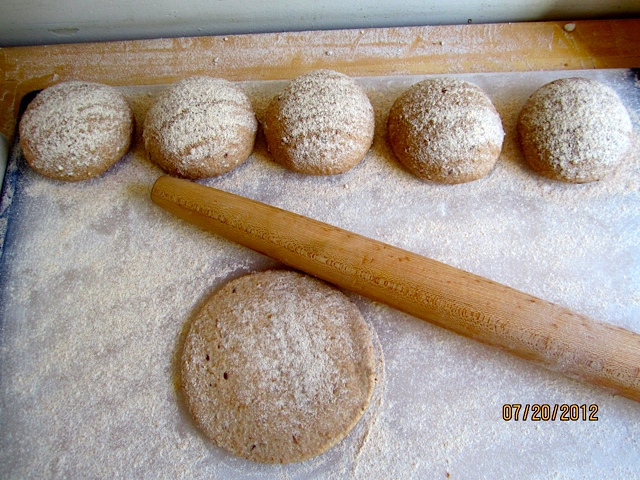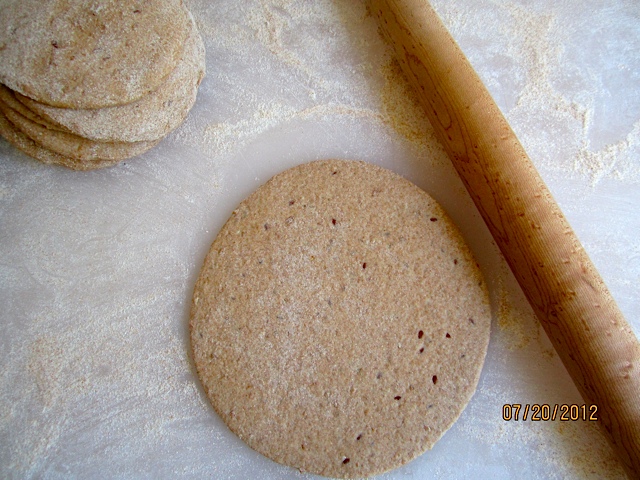
Multigrain Pitas - The Tasty Pocket

The owner of A&B Naturals, the store that sells my bread, asked me one day: "Can you bake pitas, too?" I had never made them, so I said with conviction: "Yes!"
At least I knew where I could find a pita recipe!
In "Whole Grain Breads", one of my favorite baking books, Peter Reinhart has a recipe for whole wheat pitas - just the right thing for my grain loving customers.
I started my first pita dough. No big deal, until I got to the shaping part. The pitas had to be rolled out no thinner than 1/4 inch (6 mm), and to an 8-inch (20 cm) diameter. But my pitas already reached this thickness at 6 1/2 to 7 inches (16 to 18 cm.)

Pitas are shaped in three steps, first into rolls, then rolled out to 4"/10 cm. Don't skimp on the flouring!
Below: rolling out pitas to a larger round (6 1/2 - 7" or 16 - 18 cm.) Re-flour them, if necessary.

A high oven temperature is key to a pita's proper horizontal separation into two layers. This high temperature has to be maintained during the whole bake, from below as well as from above.
Many cheaper ovens don't heat up to the necessary 550ºF (280ºC.) Without that boost pitas can't produce the large gas bubble that creates a pocket. And without a pocket - no delicious filling!
A baking stone, or a rack lined with unglazed terracotta tiles (like I have), works best for keeping the temperature stable, even when the oven door has to be opened several time during the baking process. And very hot stones make the best baking surface for pitas, too.
To reheat fast enough after each opening of the door I remembered Peter Reinhart's advice for baking pizza ("American Pie"), where the problem is the same: intermittently switching the oven to broil for a short time.
How many pitas can you bake at the same time? One batch of dough makes 8 (or 6, if you want larger ones.) Peter Reinhart says one at a time, but, of course, being a semi-professional I wanted to do it a little less time consuming.
After some trials, I found that I can put two at the same time in the oven. That's the maximum, with more it becomes very difficult to load and unload them without damage, and to keep control over their baking process.

2 pitas can be baked at the same time. Once out of the oven, they deflate quickly.

Of course, it takes a little bit of experience to slide the pitas into the oven without them folding over in one place, and to extricate them without nicking them with the peel.
But it's not rocket science, a smart child can do it:
 Josh, our carpenter's son, thought it was much more fun to help with my baking than reading his book!
Josh, our carpenter's son, thought it was much more fun to help with my baking than reading his book!
Though Peter Reinhart's original 100% whole wheat pita is very good, I made a few changes to it. I substitute a 7-grain mix for some of the whole wheat flour, and add an overnight bulk rise in the fridge, this is more practical for my baking schedule, and, in my opinion, improves the taste even more. It also has the advantage that I can reduce the yeast amount by 2 grams.
Though I usually cut down on the sweetener in Peter Reinhart's recipes, this whole grain bread needs the full dose.
We like our pita filled with grilled Halloumi cheese, tomato and lettuce - the way we had it in Girne/Kyrenia on Cyprus. And how do my customers at A&B Naturals like them? They fly off the shelf so that I have to bake them every week!
Here is a link to the recipe in my blog "Brot & Bread".



Comments
Those look great!
-Floyd
Great looking Pitas.
I have been meaning to try some myself so I will have to give your version a whirl soon enough!
Your helper looks like he can't wait to either eat one or go play a video game :).
Regards,
Ian
hanseata. Learned to love them by eating them every day when I liveds in S. Arabia. Shawarma, hummus and pita is tough to beat. Your pitas are especially nice being WW.
Maybe you can help me. When we make our pitas, one side of the bread is thicker than the other side when they puff up in the oven - nearly twice as thick. Why is that?
Nice baking - miss the seeds though :-)
I have been trying to serve more wholegrain pita lately but haven't got around to making it. Looks like you got it down. These look great. Thanks for all the tips. -Varda
I appreciate all your friendly comments.
Floyd, with that first photo I cheated a bit - those are 100% whole wheat ones, without multigrain addition. I make those when I don't have enough time to soak the grain mixture.
Please try my version, Ian. It was nice to have such an eager, interested kid to help - our ungrateful children didn't do their duty in producing grandchildren, yet.
Dabrownman, I'm never able to make completely even layers, either. The top is usually somewhat thinner. Probably because the bottom hits the hot stone and probably sets a bit earlier than the top. Also, I doubt that I roll them out completely even, one side might be a bit thinner. And I have to protest: the pitas have seeds - at least flax seeds (no hemp, though!).
Varda, these are really good, and I don't think anything much can go wrong with the recipe, I made them so often I could do it in my sleep.
When I was writing this post, I realized that in the meantime my pitas got larger - and thinner. Now I'm cutting back on the size again (to the measures given in the recipe), because they are more difficult to handle when they are too thin. I'll add a few more photos that I took today.
Karin
Great Pitas! They look very tasty, Karin!
I'am intimidated by pita baking, as the hassle of transforming rolls into discs of the right thickness, all the while loading ready ones into the oven, would get the best of my ailing back. I would love to eat one of your making.
As to cooling baked pitas, it is best to stack them covered under a towel, as crust quickly forms and may crack during packing.
Khalid
No need to be intimidated by these, Khalid. Even if you don't roll them out to the "right" thickness, the worst thing that can happen is that the upper layer is a bit thin.
If you look closely at my photos, you can see that the pitas in the first picture on the top look more even than the ones in the picture on the bottom of my post. The upper photo is much older, at that time I measured the pitas diligently when I rolled them out.
Only, when I wrote this post, I realized that over the years my pitas got larger and larger in diameter, and therefore look more "bubbly".
Now I'm downsizing them a bit again, but in principle it doesn't matter too much.Since they have to rise for 15 minutes, there is no need to load some into the oven while rolling out the others - you just always start with the first ones again.
For the cooling, whole grain pitas are more forgiving, too, they don't dry out and crack as easily as white flour ones. I can keep them for several hours uncovered, and when I want to eat them the next day, I put them in a plastic bag. Or I freeze them.
We like these so much, I always have a supply in the freezer.
Karin
Thanks, Karin! I also happen to dislike the untidy workspace often experienced with pita making. I think i'am blowing things out of propotion. Yet, i continue to seek a proper treatment for my inflammed back muscles, and until then, i'd need to avoid activities that involve frequent bending.
It has been a long while since i baked ww pita bread, and when i finally get around to baking some, i'll pay homage to your posts.
Thanks!
I wish you a speedy recovery!
Take care,
Karin